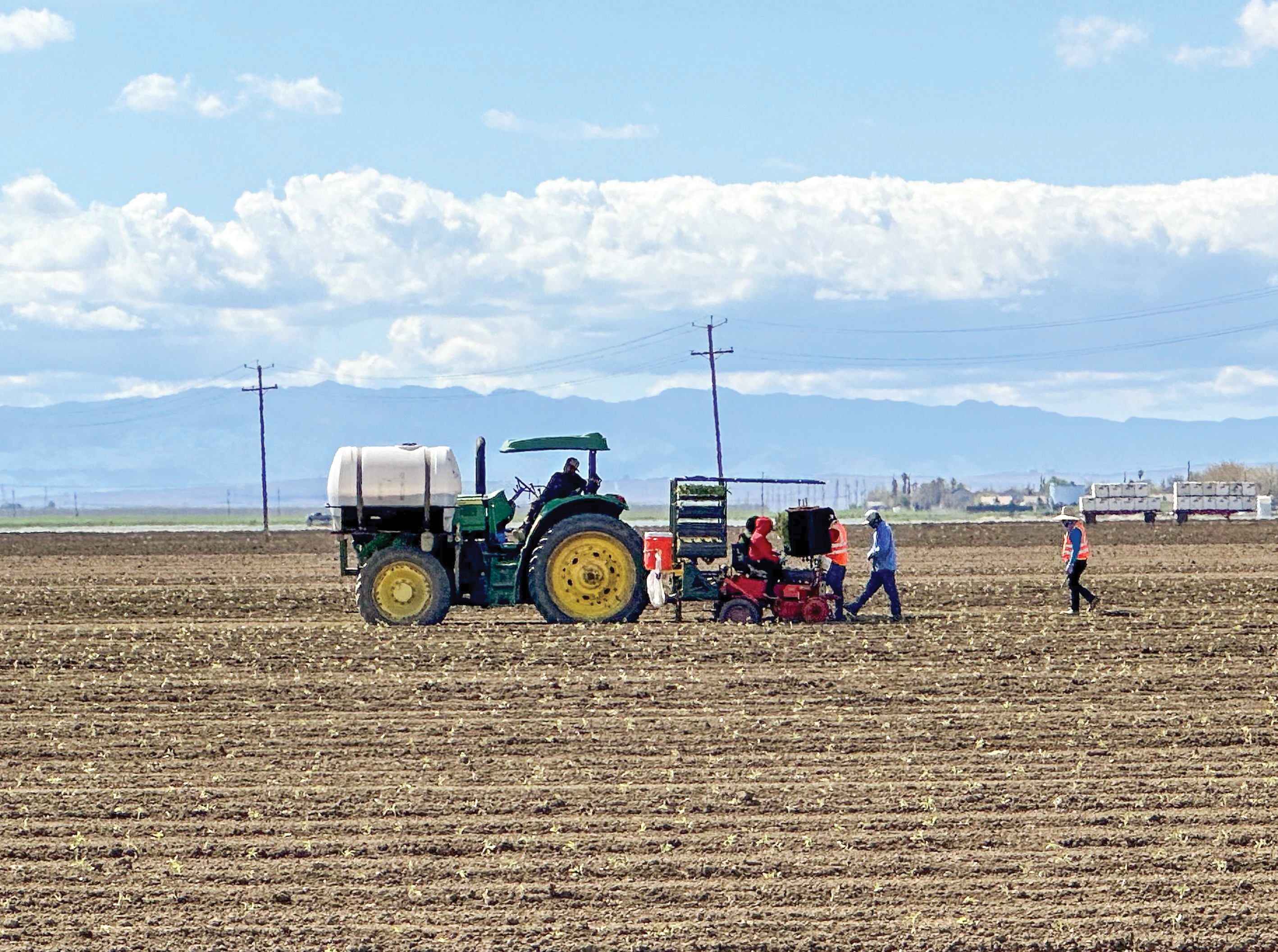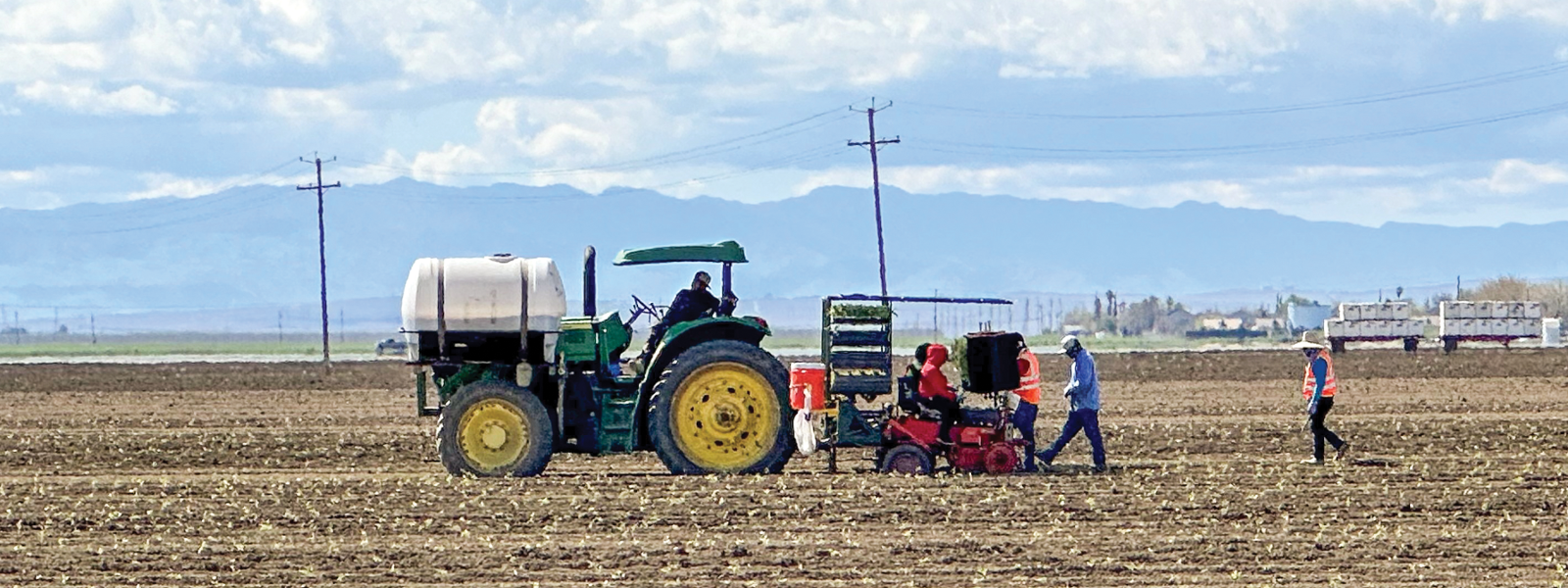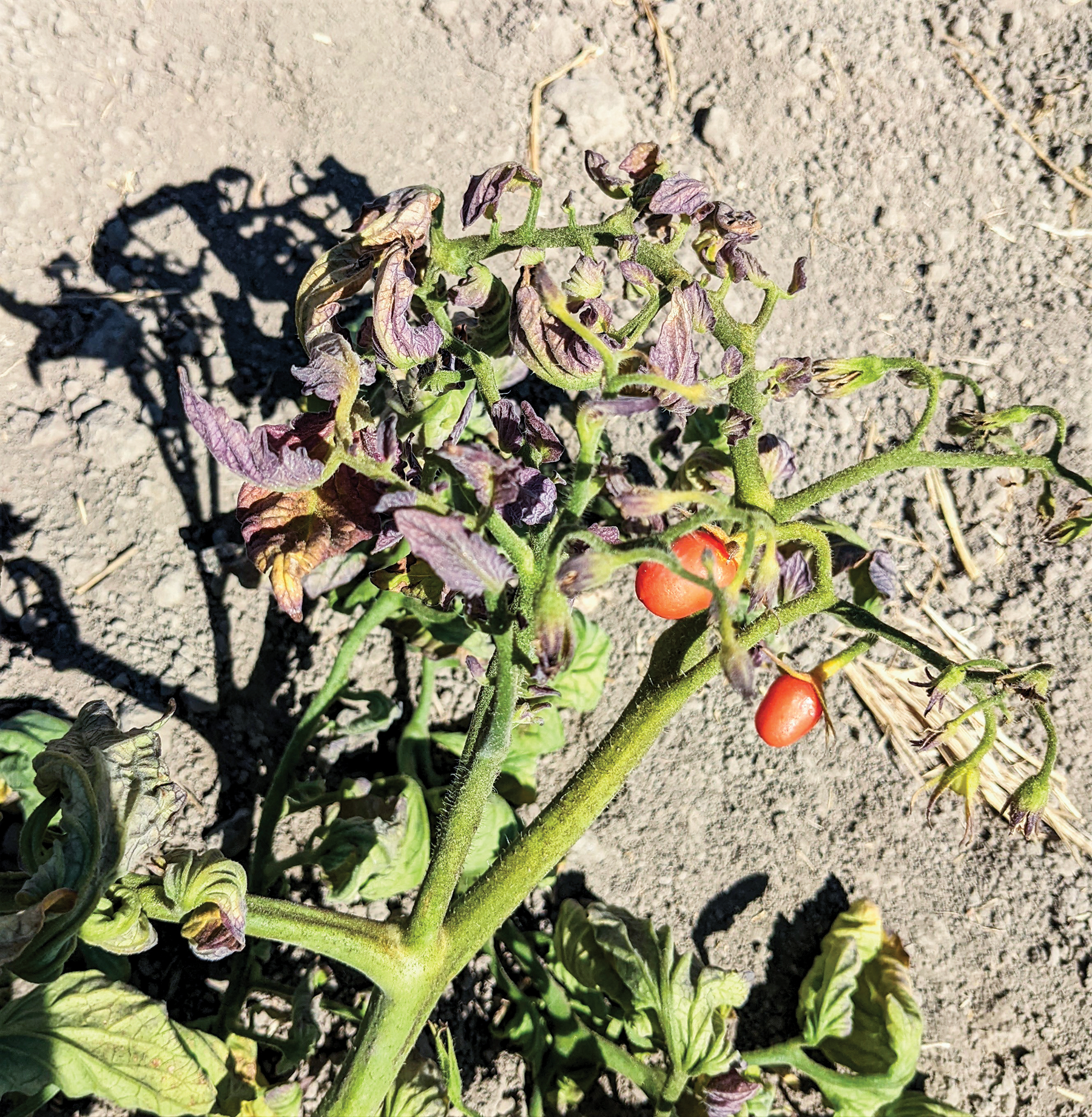Storms disrupt tomato plantings, raise pest worries

Photo/Daniel Hartwig
After planting was delayed due to a series of storms, farm employees plant processing tomatoes in Fresno County. Farmers must recalculate schedules for the harvest season, which generally runs from late June to October.


Beet curly top virus damages a tomato plant in a Sutter County field in 2022. The disease is spread by the beet leafhopper, which feeds and lays eggs in perennial weeds. The pest migrates from the foothills to valley farms as the weather warms in the spring.
By Nancy Vigran
Fresno County farmer Daniel Hartwig was looking to get a good start on planting 3,500 acres of processing tomatoes by the end of February. But the weather had different plans.
“It has put us about two weeks behind,” Hartwig said. He hesitated to plant too much all at once, explaining, “We fear too much to harvest all at one time and what does that do to the cannery?”
Processing tomatoes are typically planted in California from early February through early June for continuous harvest from the end of June into October. This year is running behind schedule, at least for many early plantings.
The weather has changed the planting schedule almost daily, Hartwig, director of sustainability at Woolf Farming in Fresno, said this month.
The deluge of recent storms is also heightening worries about the potential of increased pest problems compared to drier years.
As for pests, “the concerns we have are the concerns we have annually,” Hartwig said, adding that the highest concern is the beet leafhopper, a serious pest for tomatoes that can spread plant diseases.
Hartwig also said the ground beetle is another pest to watch for. He said the pests require extra monitoring and vigilance.
Some 40 miles to the northeast, in the Firebaugh-Los Banos area, A-Bar Ag Enterprises hadn’t started planting its processing tomatoes. Usually, it would have started by April 1, continuing through May.
“It could be a lot different this year,” said Jake Barcellos, whose family owns A-Bar Ag. Echoing some of Hartwig’s worries, he said, “I think the real concern now is for when the harvest comes around. A lot of tomatoes will need to be harvested all at once.”
Barcellos said he is also focused on potential beet leafhopper problems. The challenge, he said, is that just one leafhopper will not only feed on one plant but may get to a couple more before stopping.
While not a significant threat every year, the pest could be worrisome this year, said Amber Vinchesi-Vahl, a University of California Cooperative Extension vegetable crop advisor for Colusa, Sutter and Yuba counties.
“You can’t control it because it’s gone by the time you find it,” she said.
Beet leafhoppers feed and lay eggs in perennial weeds likely to be enhanced by this year’s rains. They tend to come down from the foothills to the valley floor as the weather warms in the spring.
The pest carries beet curly top virus, which can be deadly to tomatoes. Signs of BCTV in tomatoes include leaf curling, purpling and premature small red fruit, and stunted growth, according to Vinchesi-Vahl. She said trapping helped in some fields, with testing run for viral levels.
Barcellos said his family’s farms will be undertaking “a lot of preventative management through drip during certain times of the season.”
Another pest concern is thrips, which can cause tomato spotted wilt virus.
Signs of spotted wilt virus include curling or wilting of leaves, which can turn yellow or bronze and develop necrotic spots or rings, Vinchesi-Vahl said. It can stunt growth of the plant and lead to distorted fruit that may suffer ring spotting. To combat thrips and the virus, researchers have been working on developing resistant processing tomato strains.
There are yet other problems in tomatoes. Fusarium wilt, race 3, is an increasing problem, Vinchesi-Vahl said, noting that the fungus can live indefinitely in the soil.
It is becoming more prevalent across the state from the Sacramento region down to Bakersfield. Vinchesi-Vahl cited one former tomato field that had been planted only to rice for 20 years. The grower returned it to tomatoes and lost the whole crop to the fusarium wilt fungus.
Plants suffering from fusarium wilt may start showing signs of the disease as early as 45 days, but often may not be noticed until 60 days. One identifying sign is bright-yellow foliage, which may appear only on one branch or the entire plant.
The fruit may sunburn easily or simply rot. The only way to combat the fungus is through an accurate diagnosis combined with planting resistant cultivars.
Vinchesi-Vahl said equipment may contribute to the spread, adding equipment should be completely sanitized before moving between fields.
A new form of fusarium damaging tomatoes in recent years is fusarium falciforme foliar, Vinchesi-Vahl added. It also causes yellowing to the foliage, as well as deformities and spotting.
The new fungal disease can cause vine decline and eventual collapse. To date, there are no resistant varieties, but researchers at UC Davis are working on it, she said.
California is the nation’s leading producer of processing tomatoes, with Fresno County being the top-producing region. The other top counties include Yolo, Kings, Merced and San Joaquin, according to the U.S. Department of Agriculture.
In 2022, the contracted production of processing tomatoes in California reached 10.5 million tons, reflecting a slight dip in from 2021.
(Nancy Vigran is a reporter based in Placer County. She may be contacted via news@cfbf.com.)




